Depending who you are, you’ll either want to hang out with Night in the Woods‘ characters all the time or tell them to get off your lawn. The game is small enough to feel intimate and spacious enough to cater to different kinds of curious people. It may feel different for everyone who plays it.
Night in the Woods is a sidescrolling narrative game developed by the small team Infinite Fall. The main character, Mae Borowski, is a cat. All the characters are animals, though there are also animals in the game who are just regular animals, so have fun with that. Mae has just returned to her tiny hometown of Possum Springs after dropping out of college for mysterious reasons at age 19.
At the start of the game, her parents neglect to pick her up from the bus station, so she has to wander home through town. There’s a minor puzzle about platforming over an obstacle, a lot of reminiscing aloud, and some running into family. Later, some supernatural elements get thrown into the mix, but in the first ten minutes you’ll see most of the game’s mechanics. By the time the first of its four parts starts, you pretty much know what the game is made of.
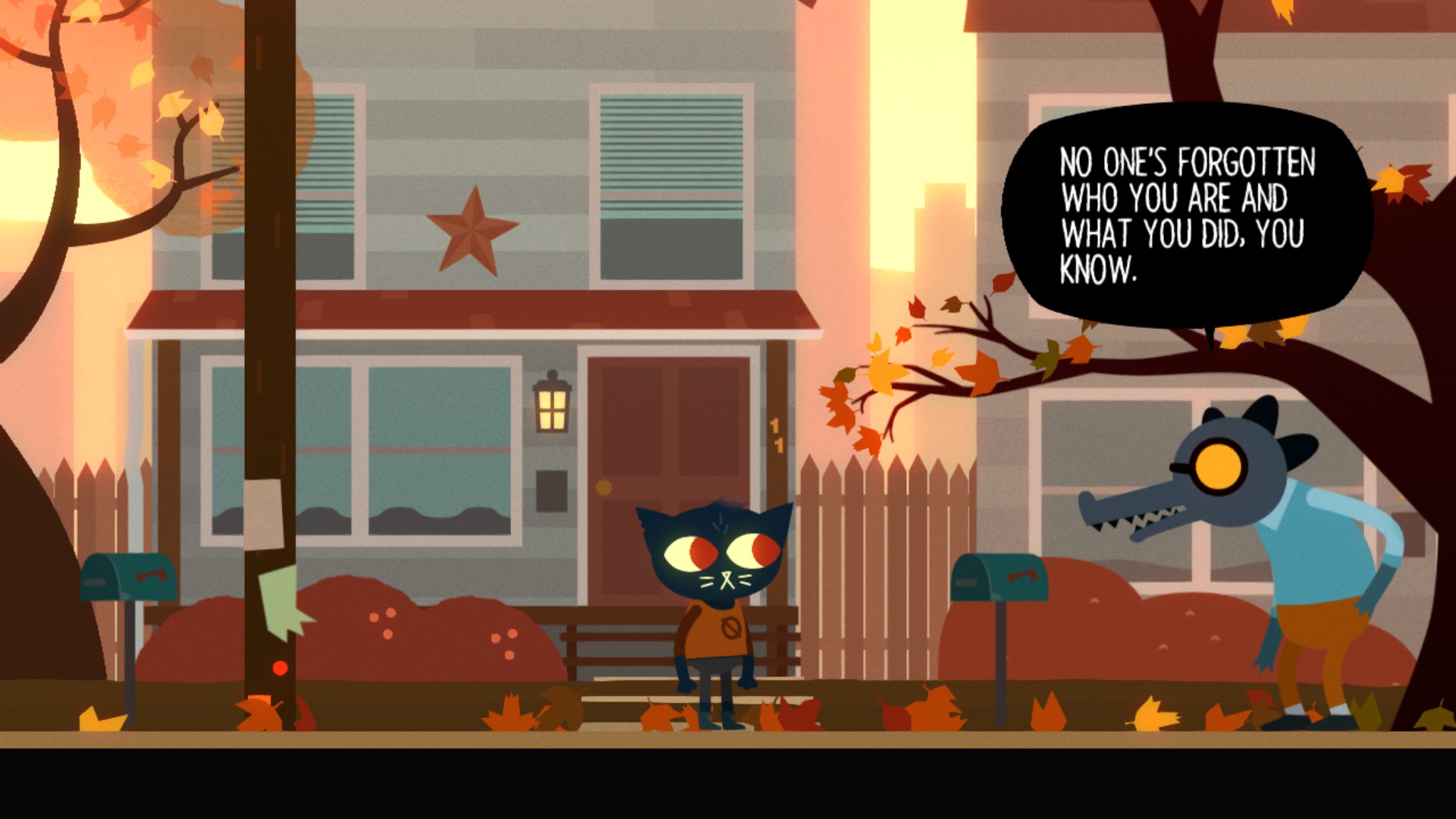
Mostly Night in the Woods is a game about wandering. Mae climbs the same hills, passes the same people, and visits the same places in Possum Springs. She chats with her neighbours, many of whom remember her from her childhood, pretty much negatively. She spends most of her time with her friends: Bea, a goth alligator who runs her father’s hardware store; Gregg, a hooligan fox who works at the delightfully-named Snack Falcon convenience store; and Gregg’s bear boyfriend Angus, who works at a video store that’s somehow still open.
They’re punks, or punk-ish, in the way kids are. They can be moody, aggressive, unpredictable, or surprisingly grown-up. They’re the kids who engaged with their lives in ways I didn’t until I was much older than them, and I felt a mix of jealousy and personal embarrassment as I steered Mae through their lives. You’ll either think that they’re super cool or that they’re annoying little shits.
Everyone but Mae has responsibilities and lives. Mae talks to them about their plans to get out of town or schemes to survive it. By contrast, Mae is irresponsible and aimless. The player can have her draw sharp-edged doodles in her journal, play a video game on her laptop, and bother her friends over the internet. Even when she gets involved in the larger machinations going on in Possum Springs, her active choices and the responsibilities she juggles are seldom more than deciding which friend to hang out with that day.
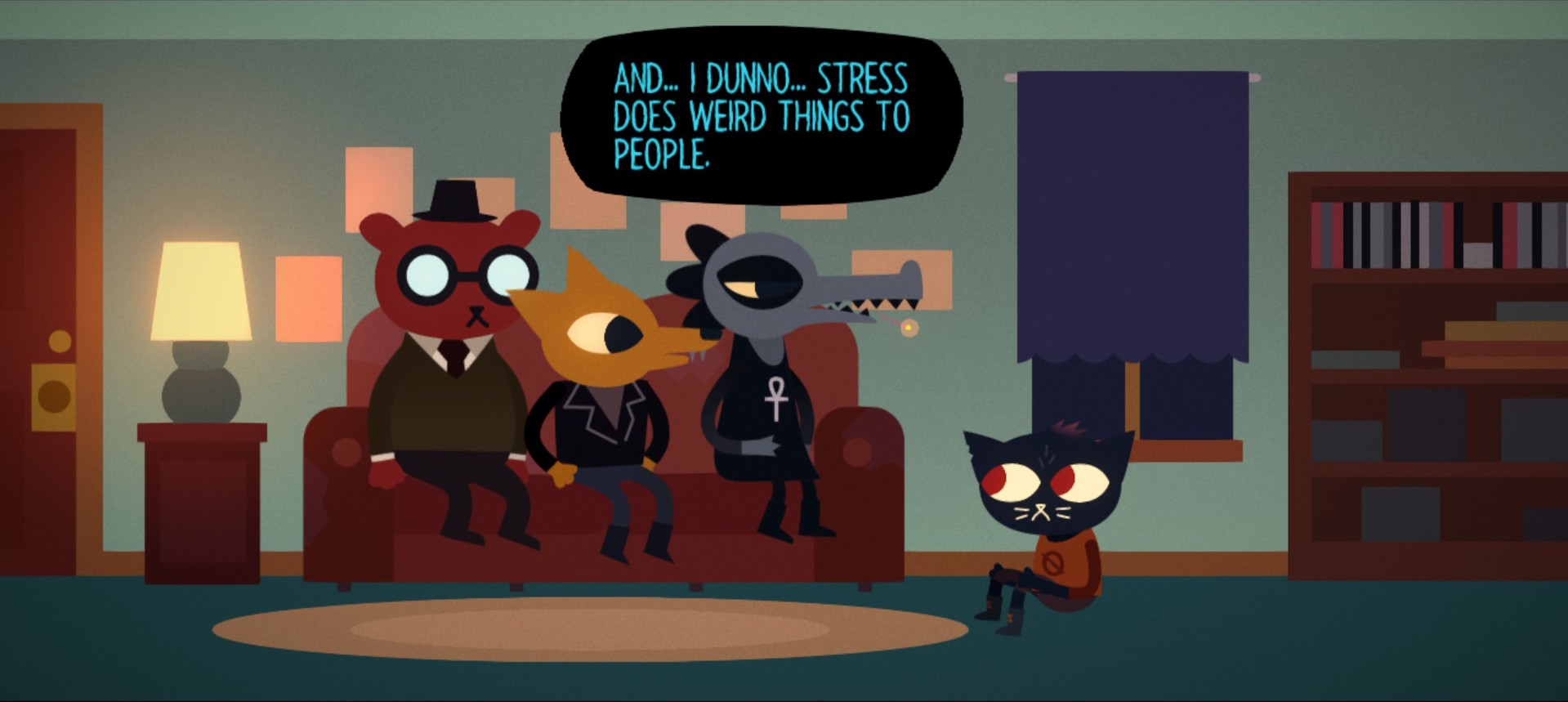
Different days present different opportunities to choose who Mae spends time with. Some of the characters will be free some days, and other days not; characters will be in a place at one time and not another. Night in the Woods’ biggest strength is the surprise that comes from mundane revelations and small moments that are unexpectedly gorgeous, intense, moving, or hilarious. These day-to-day things are so small: you do chores, partake in petty crimes, and have heavy talks with your friends.
Some events involve simple mini-games. While never too challenging, they can sometimes feel a little floaty and imprecise. Some moments — in particular a series of beautifully animated and stunningly orchestrated dream sequences — involve some jumping on power lines and rooftops that is likewise pretty simple. The puzzles might bother you, as they sometimes did me, or they will make you laugh, like I did, or they will feel like shit you did as a kid or, if you’re me, heard about cooler kids doing. Mostly they’re something to do between talking to everyone.
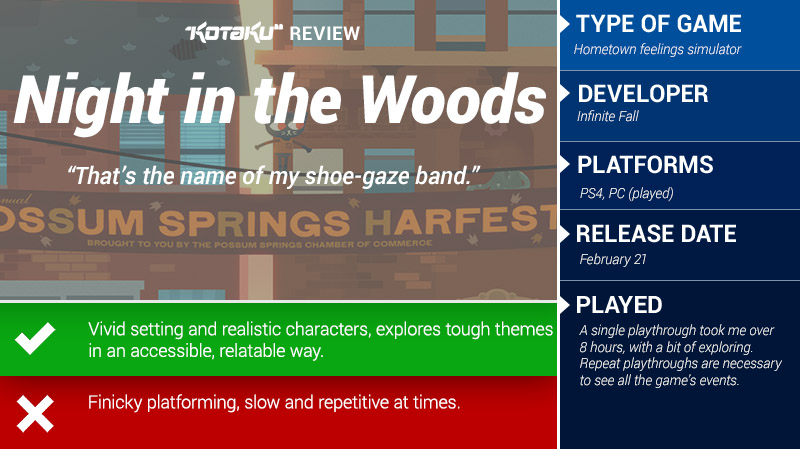
Everyone in Possum Springs mills around and talks. There’s no voice acting, and the dialogue is presented in mobile bubbles that make a soft, satisfying popping sound as the words appear. Sometimes you have dialogue options, but who you choose to talk to matters more than what you decide to say. The game deals with some intense themes — mental illness, abuse, queerness, poverty — but it addresses them like people talking rather than grand thematics. The dialogue reduced me to tears several times, but it was often a combination of the sharp writing and my own experience with the topics at hand.
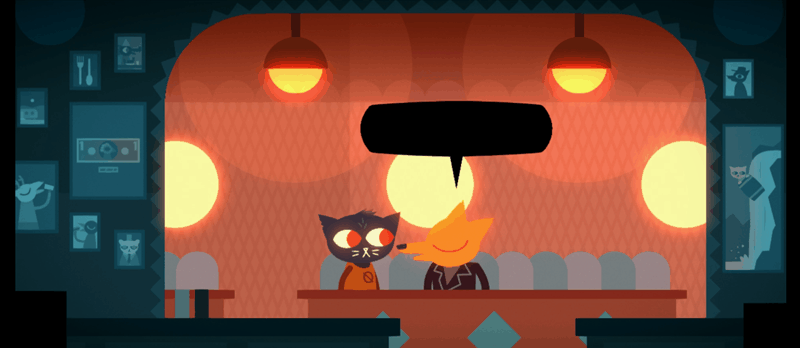
I was never a cool teen by any stretch, and a lot of the game’s hometown nostalgia was lost on me, but other parts could have been ripped straight out of my life. I’ve lived a lot of the moments in Night in the Woods: a friend confessing years of childhood abuse in a religious Pennsylvania town just like Possum Springs; learning of the death of a fellow punk in a brutally offhand way while scuffing around a parking lot with strangers; the times I’ve admitted my own mental health struggles in some sudden inappropriate-but-inevitable moment when I’ve tried not to sniffle I’m making this weird way too much.
A player with a different background might be more moved by Mae’s parents’ struggle to understand their daughter, or her friends grappling with their jobs, or the boring shit a kid sitting by the statue in the town square fills their day with. There’s a multitude of stories contained in Night in the Woods‘ main narrative, depending which encounters you have or which locations interest you. Even though the characters are animals, Night in the Woods is earnestly, humbly good at human stuff, at the messy things that make us who are.
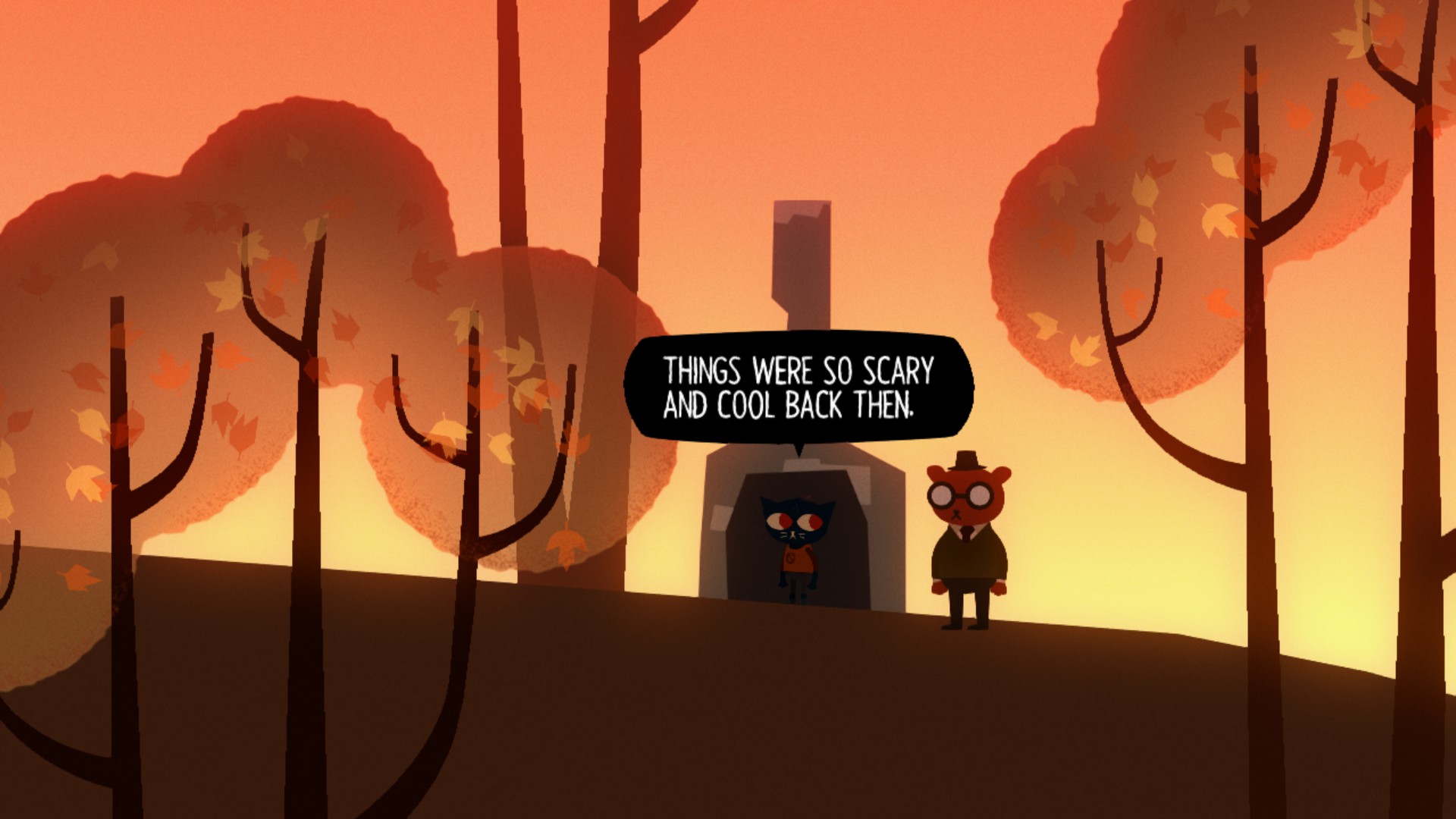
Despite this focus on character, your choices don’t create a unique version of Mae. You will, however, have a unique version of Possum Springs. Maybe it’s a religious town, if you visit the church or look at the stars. Maybe it’s full of aimless youth, if you head past the shuttered Food Donkey or out to the graveyard. Maybe there are opportunities to show kindness to everyone — animals, your mum and dad, the guys outside the bar — or maybe it’s a town that breeds violence and destruction in the parking lot and the woods. Work and the lack of it are constant. Possum Springs is haunted by the politics and tragedies of mining, of what comes after the intoxicating boom and the inevitable bust.
Night in the Woods can be a very slow game. Load screens between each area interrupt your movement through town. Possum Springs changes in subtle ways every day, but walking through basically the same areas can get repetitive. You’ll see certain animations over and over again. For example, each day ends with Mae going to bed and begins with her waking up, and while these animations were charming the first few times, I grew a little bored of them as the game arced toward its conclusion.
Certain moments and mini-games had pauses that went on a little too long. You won’t see everything in one playthrough, and while that missed content is very much worth it, repeated trips through the game might be frustrating. Much of this is offset by the subtle but elegant animations and the game’s intensely beautiful soundtrack, but while there’s a lot to the game, there’s also a shallowness.
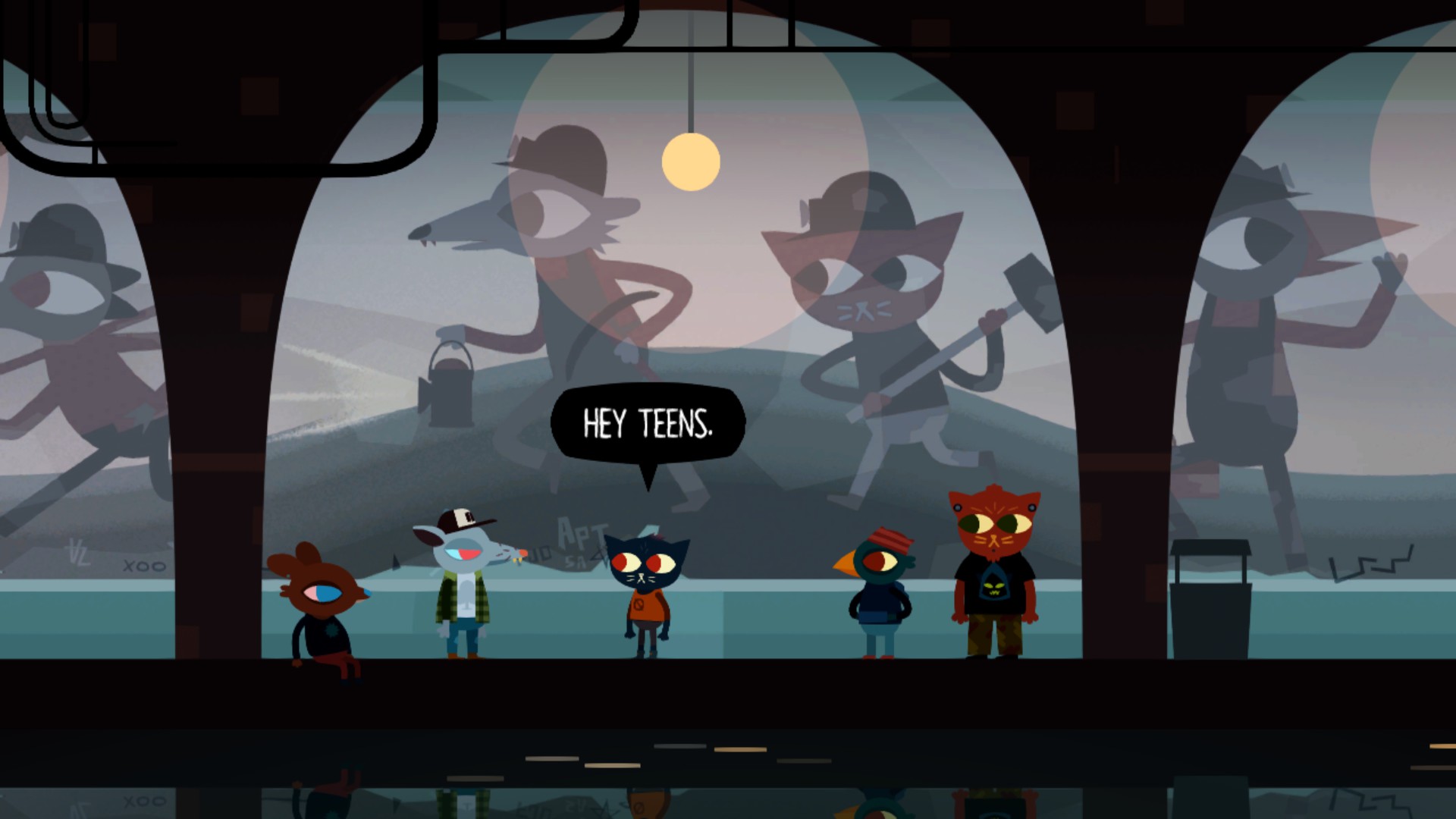
The main plot of Night in the Woods didn’t move me much, and in fact it disappointed me a little in its shift from relatable ‘people stuff’ into grander, supernatural machinations. But for me the plot was secondary to the experience of kicking around town, bumping Mae up against everybody’s lives, seeing myself, who I could have been, who I’ll never be.
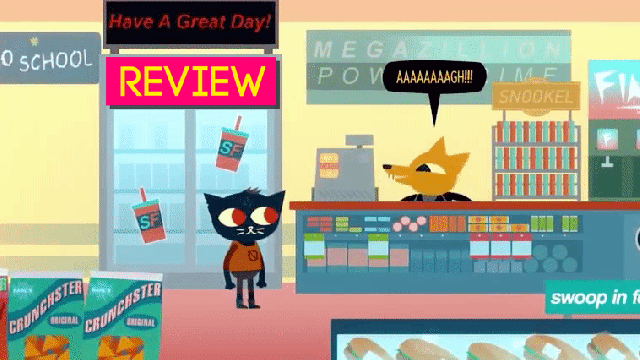
Comments